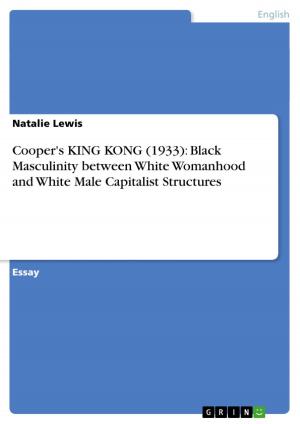King Lear: Lear's Language, Beginning vs. End of the Play
Nonfiction, Entertainment, Drama, Anthologies| Author: | Kati Bach | ISBN: | 9783638204606 |
| Publisher: | GRIN Publishing | Publication: | July 15, 2003 |
| Imprint: | GRIN Publishing | Language: | English |
| Author: | Kati Bach |
| ISBN: | 9783638204606 |
| Publisher: | GRIN Publishing |
| Publication: | July 15, 2003 |
| Imprint: | GRIN Publishing |
| Language: | English |
Seminar paper from the year 2002 in the subject English Language and Literature Studies - Linguistics, grade: 2 (B), Martin Luther University (Anglistics), course: Shakespear's Plays, 15 entries in the bibliography, language: English, abstract: King Lear was first published in 1608 and is one of the numerous tragedies written by William Shakespeare. However, it is not just any of his tragedies, the tragedy of King Lear 'stands like a colossus at the centre of Shakespeare's achievement as the grandest effort of imagination', says Foakes who is the Editor of the Arden Edition (Foakes 1997, 1). 'In its social range it encompasses a whole society, from king to beggar, and invites us to move in our imagination between a royal palace and a hovel on a bare heath' (Foakes 1997, 1). Nevertheless, 'complications have been kept to a minimum' (Brown 2001, 229) by Shakespeare. Still, this tragedy 'is as demanding as any of the others - in some ways, it is the most epic of them all' (Brown 2001, 229). Between all the commotion in the plot, Lear's story 'is the one clear and indisputable element' (Brown 2001, 229). From the beginning to the end, 'Lear's story is presented in stark and unavoidably physical terms' (Brown 2001, 231). The threefold dignity of a king, an old man, and a father, is dishonored by the cruel ingratitude of his unnatural daughters; the old king, who out of a foolish tenderness has given away everything, is driven out into the world a homeless beggar; the childish imbecility to which he was fast advancing changes into the wildest insanity, and when he is rescued from the destitution to which he was abandoned, it is too late. (Bates 1906)) In a way that was new to himself and almost unknown in the theatre of his time, Shakespeare constantly drew attention to what his hero undergoes in body as well as in mind, in his senses as well as in his thoughts and feelings, achievements, and relations with other people. (Brown 2001, 231) In this paper I am trying to follow Lear's state of mind and thought. The King goes from power to madness and from royalty to peasantry. But how does he articulate his deep thoughts and feelings through language? How can the reader understand his change in mood? The following pages will give some insight on these topics and will help to a better understanding of the character of King Lear.
Seminar paper from the year 2002 in the subject English Language and Literature Studies - Linguistics, grade: 2 (B), Martin Luther University (Anglistics), course: Shakespear's Plays, 15 entries in the bibliography, language: English, abstract: King Lear was first published in 1608 and is one of the numerous tragedies written by William Shakespeare. However, it is not just any of his tragedies, the tragedy of King Lear 'stands like a colossus at the centre of Shakespeare's achievement as the grandest effort of imagination', says Foakes who is the Editor of the Arden Edition (Foakes 1997, 1). 'In its social range it encompasses a whole society, from king to beggar, and invites us to move in our imagination between a royal palace and a hovel on a bare heath' (Foakes 1997, 1). Nevertheless, 'complications have been kept to a minimum' (Brown 2001, 229) by Shakespeare. Still, this tragedy 'is as demanding as any of the others - in some ways, it is the most epic of them all' (Brown 2001, 229). Between all the commotion in the plot, Lear's story 'is the one clear and indisputable element' (Brown 2001, 229). From the beginning to the end, 'Lear's story is presented in stark and unavoidably physical terms' (Brown 2001, 231). The threefold dignity of a king, an old man, and a father, is dishonored by the cruel ingratitude of his unnatural daughters; the old king, who out of a foolish tenderness has given away everything, is driven out into the world a homeless beggar; the childish imbecility to which he was fast advancing changes into the wildest insanity, and when he is rescued from the destitution to which he was abandoned, it is too late. (Bates 1906)) In a way that was new to himself and almost unknown in the theatre of his time, Shakespeare constantly drew attention to what his hero undergoes in body as well as in mind, in his senses as well as in his thoughts and feelings, achievements, and relations with other people. (Brown 2001, 231) In this paper I am trying to follow Lear's state of mind and thought. The King goes from power to madness and from royalty to peasantry. But how does he articulate his deep thoughts and feelings through language? How can the reader understand his change in mood? The following pages will give some insight on these topics and will help to a better understanding of the character of King Lear.















